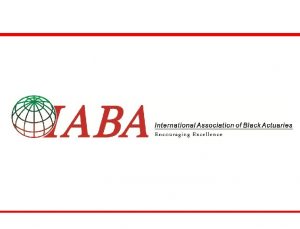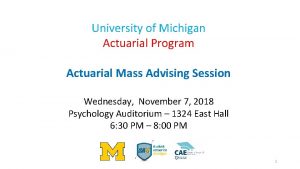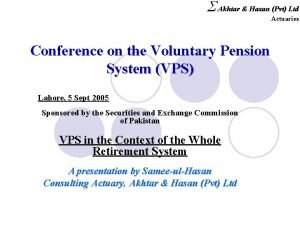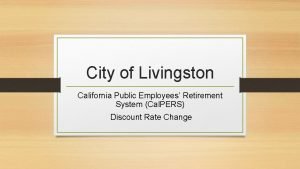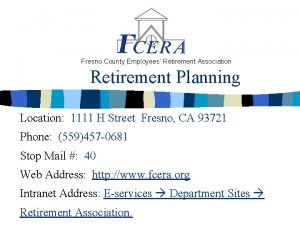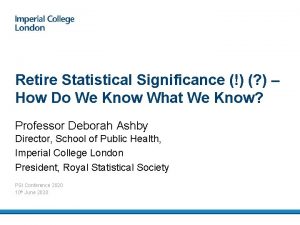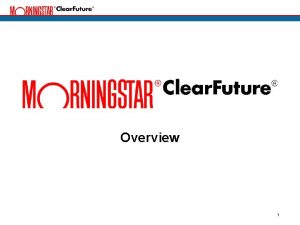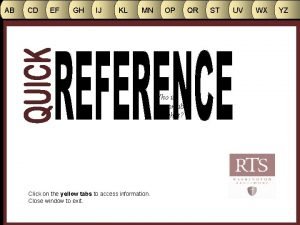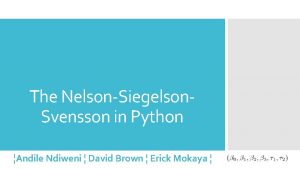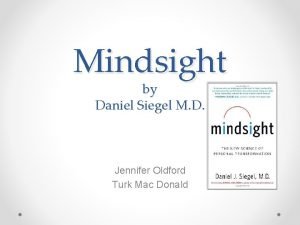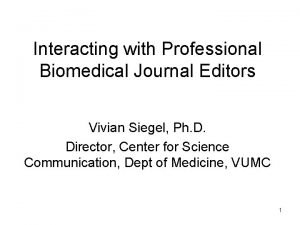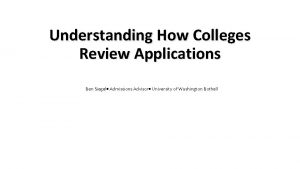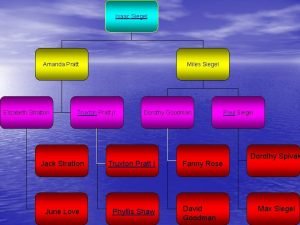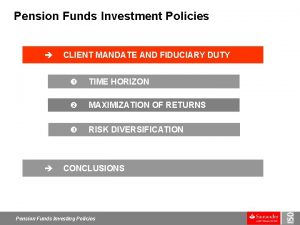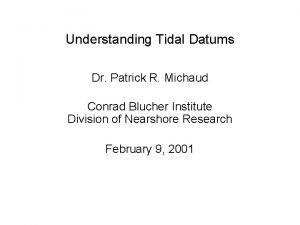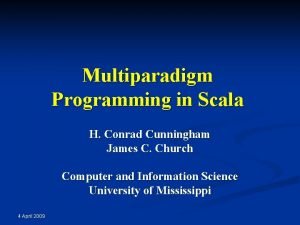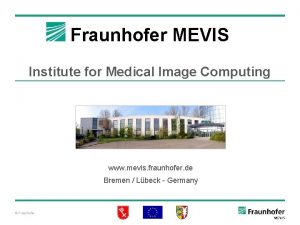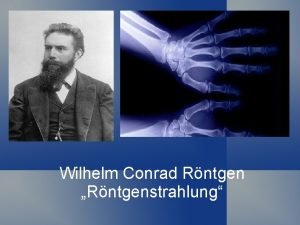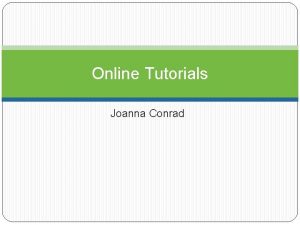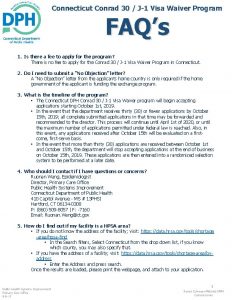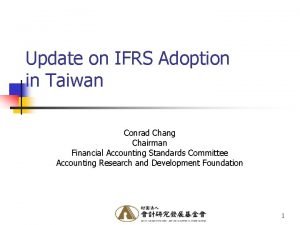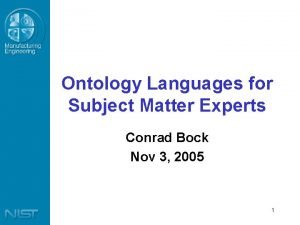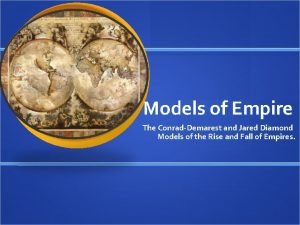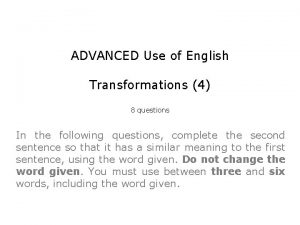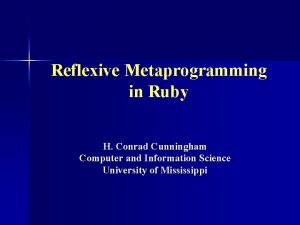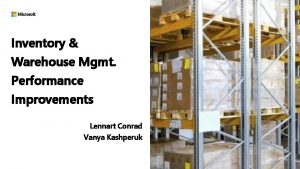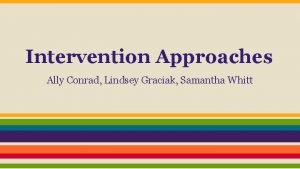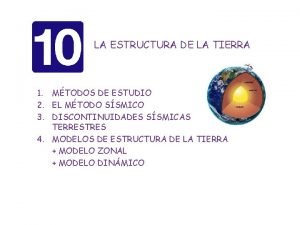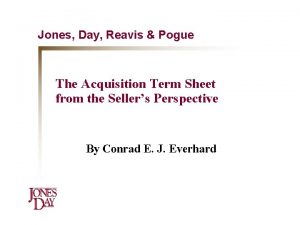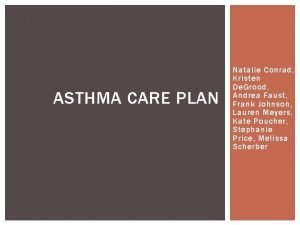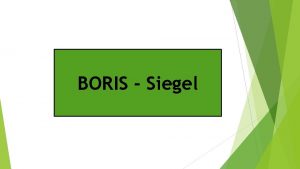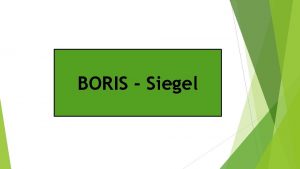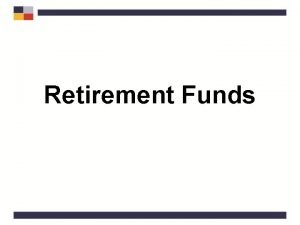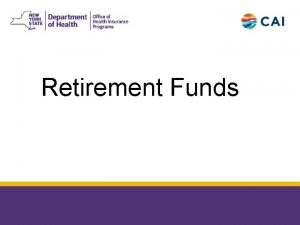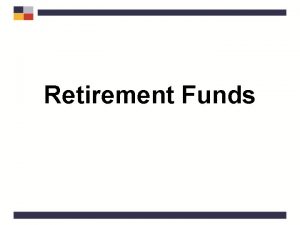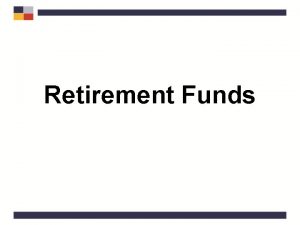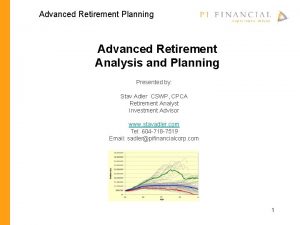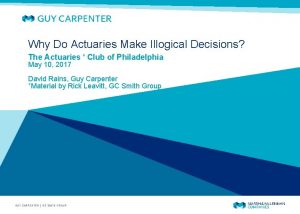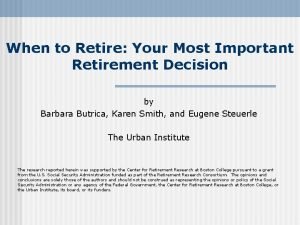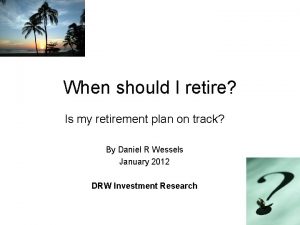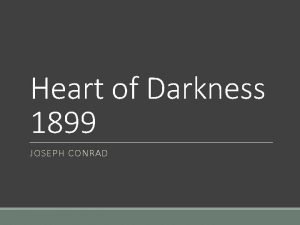READY RETIRE SET Conrad Siegel Actuaries Retirement Planning






































































- Slides: 70

READY, RETIRE! SET… Conrad Siegel Actuaries Retirement Planning Seminar

Who we are Conrad Siegel Actuaries ØHarrisburg based employee benefits firm ØThe Employee Benefits Company Conrad Siegel Investment Advisors, Inc. ØIndependent investment consultants Conrad Siegel Investment Advisors, Inc. (“CSIA”) is an SEC registered investment adviser with its principal place of business in the Commonwealth of Pennsylvania. CSIA and its representatives are in compliance with the current registration requirements imposed upon registered investment advisers by those states in which CSIA maintains clients. CSIA may only transact business in those states in which it is registered, or qualifies for an exemption or exclusion from registration requirements. Any subsequent, direct communication by CSIA with a prospective client shall be conducted by a representative that is either registered or qualifies for an exemption or exclusion from registration in the state where the prospective client resides. For information pertaining to the registration status of CSIA, please contact CSIA or refer to the Investment Adviser Public Disclosure web site (www. adviserinfo. sec. gov). For additional information about CSIA, including fees and services, send for our disclosure statement as set forth on Form ADV from CSIA using the contact information herein. Please read the disclosure statement carefully before you invest or send money. 2

Questions we will address Ø What will be my level of expenses in retirement? Ø What will be my sources of income in retirement? Ø What risks are associated with my retirement expenses & retirement income? Ø What other issues should I consider in retirement? 3

Financial Goal in Retirement = Expenses Retirement Income 4

Financial Goal in Retirement = Expenses Retirement Income Revisit When Major Changes Occur Examples ØChange in Marital Status ØChange in Living Arrangements ØChange in Physical Abilities 5

Financial Goal in Retirement = Expenses Retirement Income Phases in Retirement ØPhase 1 – Most active ØPhase 2 – Decline in physical/mental abilities ØPhase 3 – Least active and will need help 6

Estimating Retirement Expenses Methods for Estimating Retirement Expenses: Ø 1. Replacement ratio method Ø 2. Detailed analysis method 7

Estimating Retirement Expenses 1. Replacement ratio method (Step A): Description Dollars Pre-Retirement Compensation $50, 000 Percentage 100% 8

Estimating Retirement Expenses 1. Replacement ratio method (Step B): Description Dollars Pre-Retirement Compensation $50, 000 Percentage 100% Expenses Eliminated Post-Retirement Employee Retirement Contributions – 5, 000 – 10. 00% Social Security Contributions – 3, 825 – 7. 65% State & Local Taxes – 2, 500 – 5. 00% Work-Related Expenses – 1, 000 – 2. 00% Personal Savings – 2, 000 – 4. 00% Subtotal 35, 675 71. 35% 9

Estimating Retirement Expenses 1. Replacement ratio method (Step C): Dollars Description Pre-Retirement Compensation $50, 000 Percentage 100% Expenses Eliminated Post-Retirement Employee Retirement Contributions – 5, 000 – 10. 00% Social Security Contributions – 3, 825 – 7. 65% State & Local Taxes – 2, 500 – 5. 00% Work-Related Expenses – 1, 000 – 2. 00% Personal Savings – 2, 000 – 4. 00% Subtotal 35, 675 71. 35% Expenses Added Post-Retirement Health Insurance Costs + 4, 000 + 8. 00% Additional Leisure Time Activities + 4, 000 + 8. 00% 10

Estimating Retirement Expenses 1. Replacement ratio method: Description Dollars Pre-Retirement Compensation $50, 000 Percentage 100% Expenses Eliminated Post -Retirement Employee Retirement Contributions – 5, 000 – 10. 00% Social Security Contributions – 3, 825 – 7. 65% State & Local Taxes – 2, 500 – 5. 00% Work-Related Expenses – 1, 000 – 2. 00% Personal Savings – 2, 000 – 4. 00% Subtotal 35, 675 71. 35% Expenses Added Post-Retirement Health Insurance Costs + 4, 000 + 8. 00% Additional Leisure Time Activities + 4, 000 + 8. 00% Post-Retirement Income Needed $43, 675 87. 35% 11

Estimating Retirement Expenses 2. Detailed Analysis Method: Ø Use the Retirement Expenses Worksheet to Project Retirement Expenses Sample Category Expense Items: Housing Utilities Food Transportation Personal Appearance Entertainment Savings Debt payments Medical 12

Estimating Retirement Expenses 2. Detailed Analysis Method: Monthly Expenses can be further divided into: A. Fixed Expenses, for example: Ø Groceries Ø Utilities Ø Housing B. Flexible Expenses that can be reduced if necessary, for example: Ø Travel Ø Hobbies Ø Entertainment 13

Major Risks - Retirement Expenses Ø 1. Unexpected Health Care Costs & Needs Ø 2. Loss of Ability to Live Independently Ø 3. Inflation 14

1. Health Care Costs & Needs Ways to Reduce Risk of Unexpected Health Care Costs Ø Employer-Provided Plan Ø Medicare Program Ø Medicare Advantage Insurance Ø Medigap Insurance Ø Healthy Lifestyle 15

1. Health Care Costs & Needs “Bridge” Medical Insurance Needed if Retiring Prior to Medicare Eligibility (Age 65) Options for “Bridge” Coverage Ø Employer COBRA coverage will be available for 18 months after retirement Ø Some employers (becoming less prevalent) will provide continued medical insurance coverage in addition to COBRA coverage Ø If your spouse is working, you may be able to purchase inexpensive coverage through your spouse’s medical insurance plan at work Ø Individual medical insurance policy may be purchased directly from insurance company 16

1. Health Care Costs & Needs Medicare Program Ø Part A – Hospital Insurance Ø Part B – Medical Insurance Ø Part C – Medicare Advantage Plans Ø Part D – Prescription Drug Coverage Ø Information available at www. medicare. gov 17

1. Health Care Costs & Needs Medicare Part A – Hospital Insurance Ø Qualify at age 65 if you or your spouse are eligible for Social Security Benefits Ø No cost if eligible for Social Security Benefits Key coverage Ø Ø Hospital & Hospice care Post-hospital extended care 18

1. Health Care Costs & Needs Medicare Part B – Medical Insurance Ø Qualify for Part B if eligible for Part A Ø 2010 monthly premium is $96. 40 or $110. 50 if income is below $85, 000 (single), or $170, 000 (married) Key coverage Ø Services of physicians Ø Certain services of dental surgeons, optometrists, chiropractors, and podiatrists Ø Certain additional medical services 19

1. Health Care Costs & Needs Medicare Part D – Prescription Drug Coverage Ø Prescription drug coverage (optional) Ø If you do not sign up at time of initial eligibility for Medicare, penalty may apply Ø Costs vary by plan 20

1. Health Care Costs & Needs Medicare – When to Apply Ø Contact Social Security at least 3 months before you or your spouse reaches age 65 Ø Contact Social Security even if you don’t plan to retire 21

1. Health Care Costs & Needs Medicare Part C – Medicare Advantage Plans Ø Combines Part A & Part B coverage Ø May Include Part D coverage (prescription drug) Ø Coverage provided by approved private insurance companies 22

1. Health Care Costs & Needs Medicare Advantage Insurance Ø Sample Cost of Medicare Advantage Insurance in Addition to $96. 40/$110. 50 Monthly Premium for Medicare Part B – Highmark Freedom. Blue PPO 2010 Monthly Cost Option 1 $34 Option 2 $102 Option 3 $138 23

1. Health Care Costs & Needs Medigap Insurance Ø Supplement to Medicare benefits to cover gaps in Medicare coverage Ø Difference between Medigap & Medicare Advantage 24

1. Health Care Costs & Needs Medigap Insurance Ø Sample Cost of Medigap Insurance in Addition to $96. 40/$110. 50 Monthly Premium for Medicare Part B – Capital Blue Cross 2010 Monthly Cost Plans at Age 65 Plan A $102 Plan B $134 Plan C $172 25

2. Inability to Live Independently What is Long Term Care? Ø Long-term care is a variety of services and supports to meet health or personal care needs over an extended period of time. Ø Most long-term care is help performing Activities of Daily Living (ADLs): Bathing, Dressing, Using the toilet, Transferring (to or from bed or chair), Caring for incontinence, and Eating 26

2. Inability to Live Independently What are the risks and the costs of LTC? ØAbout 60 percent of individuals over age 65 will require at least some type of long-term care. ØLong term care is high in cost*: Ø$223 average per day ($81, 395 per year) in a nursing home for semi-private room Ø$3, 186 per month (average) in assisted living facility Ø$24 per hour (average) for a home health aide * 2008 Pennsylvania Survey by Genworth Financial 27

2. Inability to Live Independently What are ways to Fund Long Term Care? a. Long Term Care Insurance b. Medicaid c. Personal Assets d. Care by Family Members 28

2. Inability to Live Independently What is the cost of LTC Insurance? Comprehensive Policy with: 1. $150 daily benefit, 2. five years of coverage, and 3. 4% inflation protection Age of Purchase Annual Premium 50 $1, 285 65 $2, 746 75 $4, 734 Source: Federal Long Term Care Insurance Program 29

2. Inability to Live Independently Medicaid (Different from Medicare) ØMedicaid is available only to people with limited income ØFor specific information about Medicaid (eligibility, coverage and services) contact your state’s Medicaid office 30

3. Inflation Risk $30, 000 At Age 65 $54, 183 At Age 85 31

3. Inflation Risk Longevity: Source: Society of Actuaries Retirement Participant 2000 Table 32

Estimating Retirement Income Sources of Retirement Income: Ø 1. Social Security Ø 2. Employer Retirement Plan Ø 3. Personal IRA Ø 4. Home Ownership Ø 5. Other Personal Assets Ø 6. Part-time Employment 33

Estimating Retirement Income 1. Social Security Retirement Benefits: Ø Contact your local Social Security office, or go to www. ssa. gov to request an estimate of your Social Security retirement benefits. 34

Estimating Retirement Income 1. Social Security Full Retirement Age: Age 62 Benefit (% of Full Benefit) Year of Birth Full Retirement Age 1942 65 and 10 months 75. 8% 1943 -1954 66 75. 0% 1955 66 and 2 months 74. 2% 1956 66 and 4 months 73. 3% 1957 66 and 6 months 72. 5% 1958 66 and 8 months 71. 7% 1959 66 and 10 months 70. 8% 1960 or later 67 70. 0% 35

Estimating Retirement Income 1. Social Security – Tax on Retirement Benefits Ø 50% of Social Security benefits are taxable if income is between: Ø $25, 000–$34, 000 (single) Ø $32, 000–$44, 000 (married) Ø up to 85% of Social Security benefits are taxable if income is over: Ø $34, 000 (single) Ø $44, 000 (married) Ø Income thresholds not adjusted for inflation 36

Estimating Retirement Income 1. Social Security – Reduction if Working Ø No reduction after attaining full retirement age Ø If you are under full retirement age and receiving Social Security benefits, those benefits will be reduced: Ø Prior to the year you reach full retirement age – Reduction of $1 for each $2 you earn above $14, 160 Ø In the year you reach full retirement age – Reduction of $1 for each $3 you earn above $37, 680 for income received prior to the month that you reach full retirement age 37

Estimating Retirement Income 2 a. Employer Defined Benefit Pension Plan Ø Guarantee of lifetime monthly income starting at retirement age Ø Benefits vary significantly by employer Ø This type of benefit is becoming less prevalent Ø Investment and longevity risks assumed by employer 38

Estimating Retirement Income 2 b. Employer Defined Contribution Retirement Plan Ø 401 k, 403(b), profit sharing, ESOP, or money purchase pension Ø Funded by employer and/or employee contributions Ø No guarantee of lifetime income Ø Benefit described in terms of an account balance Ø This type of benefit is becoming very popular 39

Estimating Retirement Income 3. Personal IRA Ø Similar to defined contribution retirement plan Ø Investments controlled by individual Ø Funded by personal contributions or rollover from employer plan Ø No guarantee of lifetime income Ø Benefit described in terms of an account balance 40

Estimating Retirement Income 4. Home Ownership Ø Some people are counting on this asset to assist in retirement Ø Be realistic about how much of your home equity might be available…. . you will always need housing Ø Reverse Mortgages – how do they work? Ø Payments made to you while living Ø Loan repaid at death or upon sale of home 41

Estimating Retirement Income 5. Other Personal Assets Ø Inheritance Ø Collectibles Ø Investment Real Estate Ø Other investments 42

Estimating Retirement Income 6. Part-Time Employment Ø Phased retirement Ø Supplement income Ø Still allow time for other activities 43

Major Risks - Retirement Income 1. Asset Allocation 2. Longevity: Outliving Your Retirement Resources 44

1. Asset Allocation Phases of Retirement Investing Phase Primary Goal Secondary Goal 1. Accumulation Growth Protection 2. Transition Protection Prudent Growth 3. Withdrawal Preservation Modest Growth 45

1. Asset Allocation Dilemma with Investment of Account a. Invest Too Conservatively – run risk of not keeping up with inflation and not accumulating sufficient retirement assets b. Invest Too Aggressively – run risk of severe stock market decline around retirement age and having insufficient assets for remainder of retirement 46

1. Asset Allocation Risk Due to Sequence of Investment Returns During Transition Phase Ø Account balance at retirement - $100, 000 Ø Annual withdrawal - $5, 000 initially adjusted for 3% inflation each subsequent year. Ø Each withdraws a total of $134, 380 over 20 years. Annual Investment Returns Sue John Year 1 18% -6% Years 2 -19 6% 6% Year 20 -6% 18% Average 20 Year return 6% 6% 47

1. Asset Allocation Ø Account balance after 20 years Sue John 48

1. Asset Allocation Factors Affecting Asset Allocation Ø Investment Objective - Retirement Ø Time Horizon - Retirement age and later Ø Risk Tolerance - What type of risk taker are you? Ø Personal Situation – Other personal factors to consider? 49

2. Longevity Outliving Your Retirement Resources Source: Society of Actuaries Retirement Participant 2000 Table 50

2. Longevity Outliving Your Retirement Resources Possible Approaches Ø a. Guaranteed Income Options Ø b. Low Initial Withdrawal Ø c. Managed Payout Mutual Funds (New) 51

2. Longevity Outliving Your Retirement Resources a. Guaranteed Income Options Ø Social Security provides guaranteed lifetime income adjusted for cost-of-living Ø Employer defined benefit pension plan may also provide guaranteed lifetime income Ø May want to consider using a portion of your other retirement/personal assets to purchase annuity contract 52

2. Longevity Outliving Your Retirement Resources b. Low Initial Withdrawal Example – “ 4% Solution” Ø Initial withdrawal equal to 4% of account balance Ø Subsequent withdrawal adjusted for cost-of-living Ø 90+% probability of not depleting account for 30 years if invested using a 50% equity/50% fixed income mix 53

2. Longevity Probability of Running Out of Money Before 30 Years Have Elapsed Study* by Professors Spitzer, Strieter and Singh Journal of Financial Planning – October, 2007 Issue * - study used stock & bond returns from 1926 through 2005. Initial withdrawal of 4% of account with subsequent withdrawals adjusted for inflation. 54

2. Longevity Outliving Your Retirement Resources c. Managed Payout Mutual Funds (New Product) Ø Initial Withdrawal Percentage Varies (3% to 7%) Ø Subsequent Withdrawals Adjusted Based on Performance Ø Professionally Managed by Mutual Fund Ø No Guarantees Ø Examples: Vanguard Managed Payout Funds Fidelity Income Replacement Funds 55

Creating Your Retirement Plan Steps for Creating Your Retirement Plan Ø Ø a. Estimate Retirement Expenses b. Estimate Retirement Income c. Compare Expenses to Income d. Make Adjustments to Expenses and/or Income Your Retirement Plan should be reviewed on a periodic basis to reflect changes in your personal situation. 56

Example – Step 1 Estimate Expenses Using Replacement Ratio Method 57

Example – Step 2 Estimate Income Current Assets Withdrawal Percentage Annual Income N. A. $15, 216 Employer DC Ret. Plan $250, 000 4. 0% 10, 000 Personal IRA 50, 000 4. 0% 2, 000 Home 150, 000 0. 0% 0 Other Assets 100, 000 4. 0% 4, 000 Employment N. A. 0 Total Income $31, 216 Income Source Soc. Sec. /Employer DB 58

Example – Step 3 Compare Estimated Income and Expenses Income Source Soc. Sec. /Employer DB Current Withdrawal Assets Percentage Annual Income N. A. $15, 216 $250, 000 4. 0% 10, 000 50, 000 4. 0% 2, 000 Home 150, 000 0. 0% 0 Other Assets 100, 000 4. 0% 4, 000 Employment N. A. 0 Estimated Income Expenses $31, 216 $43, 675 Employer Retirement Personal IRA Shortfall of $12, 459 59

Example – Step 4 Possible Remedies: 1) Reduce discretionary expenses 2) Continue working for a few more years 3) Assume increased risk by increasing initial withdrawal % 4) Work part-time during retirement 5) Tap home equity for additional income 60

Example – Step 4 Possible Remedy 1 – Reduce Expenses Income Source Soc. Sec. /Employer DB Current Withdrawal Assets Percentage Annual Income N. A. $15, 216 $250, 000 4. 0% 10, 000 50, 000 4. 0% 2, 000 Home 150, 000 0. 0% 0 Other Assets 100, 000 4. 0% 4, 000 Employment N. A. 0 Total Projected Income Expenses $31, 216 $43, 675 Employer Retirement Personal IRA 61

Example – Step 4 Possible Remedy 2 – Continue Working Fulltime Income Source Soc. Sec. /Employer DB Current Withdrawal Assets Percentage Annual Income N. A. $15, 216 $250, 000 4. 0% 10, 000 50, 000 4. 0% 2, 000 Home 150, 000 0. 0% 0 Other Assets 100, 000 4. 0% 4, 000 Employment N. A. 0 Total Projected Income Expenses $31, 216 $43, 675 Employer Retirement Personal IRA 62

Example – Step 4 Possible Remedy 3 – Increase Initial Withdrawal Income Source Soc. Sec. /Employer DB Current Withdrawal Assets Percentage Annual Income N. A. $15, 216 $250, 000 4. 0% 10, 000 50, 000 4. 0% 2, 000 Home 150, 000 0. 0% 0 Other Assets 100, 000 4. 0% 4, 000 Employment N. A. 0 Total Projected Income Expenses $31, 216 $43, 675 Employer Retirement Personal IRA 63

Example – Step 4 Possible Remedy 4 – Work Part-time Income Source Soc. Sec. /Employer DB Employer Retirement Current Withdrawal Assets Percentage N. A. Annual Income N. A. $15, 216 $250, 000 4. 0% 10, 000 50, 000 4. 0% 2, 000 Home 150, 000 0. 0% 0 Other Assets 100, 000 4. 0% 4, 000 Employment N. A. 0 Personal IRA Total Projected Income $31, 216 Expenses $43, 675 64

Example – Step 4 Possible Remedy 5 – Tap Home Equity Income Source Soc. Sec. /Employer DB Current Withdrawal Assets Percentage Annual Income N. A. $15, 216 $250, 000 4. 0% 10, 000 50, 000 4. 0% 2, 000 Home 150, 000 0. 0% 0 Other Assets 100, 000 4. 0% 4, 000 Employment N. A. 0 Total Projected Income Expenses $31, 216 $43, 675 Employer Retirement Personal IRA 65

Example – Step 4 Summary of Possible Remedies: 1) Adjust discretionary expenses downward 2) Continue working for a few more years to increase assets and to increase social security/pension plan payments 3) Assume increased risk by increasing initial withdrawal % 4) Work part-time during retirement 5) Tap home equity for additional income 66

Example – Step 5 Estimate after Using Remedies #1 and 2 Income Source Soc. Sec. /Employer DB Current Withdrawal Assets Percentage Annual Income N. A. $19, 000 $325, 000 4. 0% 13, 000 65, 000 4. 0% 2, 600 Home 150, 000 0. 0% 0 Other Assets 130, 000 4. 0% 5, 200 Employment N. A. 0 Total Projected Income Expenses $39, 800 Employer Retirement Personal IRA 67

Other Retirement Issues Other Considerations Ø Estate Planning – Do you have a will? Does your will need to be updated? Ø Power of Attorney - Designate an agent to make important decisions for you in accordance with your wishes Ø Living Will - State in advance your wishes regarding medical treatment and lifesustaining procedures 68

Other Retirement Issues Other Considerations Ø Inform Family Members – Discuss your plans with the appropriate family members Ø Leisure Time Activities – What will you do with your free time? 69

Conrad Siegel Actuaries Retirement Planning Seminar
 Conrad siegel actuaries
Conrad siegel actuaries Total set awareness set consideration set
Total set awareness set consideration set Training set validation set test set
Training set validation set test set Stay ready so you don't have to get ready
Stay ready so you don't have to get ready International association of black actuaries
International association of black actuaries Actuaries act 2006
Actuaries act 2006 Student actuaries at michigan
Student actuaries at michigan Akhtar & hasan actuaries
Akhtar & hasan actuaries Keogh plan definition
Keogh plan definition Livingston federal employee retirement planning
Livingston federal employee retirement planning Retirement planning warsaw
Retirement planning warsaw Planning for retirement windsor
Planning for retirement windsor Fresno retirement planner
Fresno retirement planner Pre-hire to retire
Pre-hire to retire Pulmofluid sirop
Pulmofluid sirop Retire statistical significance
Retire statistical significance Retire online pearson
Retire online pearson Strip or retire
Strip or retire Navegue fernando pessoa
Navegue fernando pessoa Retire.hartfordlife.com
Retire.hartfordlife.com Qual a frase abaixo não apresenta ambiguidade
Qual a frase abaixo não apresenta ambiguidade Pr retire americanfunds
Pr retire americanfunds Ready set go transition inventory
Ready set go transition inventory Ready, get set, kahoot!
Ready, get set, kahoot! Go maths
Go maths Terri ballenger belcher
Terri ballenger belcher Ready set go
Ready set go Ready set bingo
Ready set bingo Daniel siegel handmodell
Daniel siegel handmodell Nelson-siegel model python
Nelson-siegel model python Rumus nelson
Rumus nelson What are the 7 senses
What are the 7 senses Lap id
Lap id Das siegel gottes
Das siegel gottes Risa siegel
Risa siegel Vivian siegel
Vivian siegel Risa siegel
Risa siegel Ben siegel uw
Ben siegel uw Isaac siegel
Isaac siegel Dr les siegel
Dr les siegel Jeremy siegel
Jeremy siegel Risa siegel
Risa siegel Martin siegel stabilitas
Martin siegel stabilitas Risa siegel
Risa siegel Mllw meaning
Mllw meaning Conrad cunningham
Conrad cunningham Summary of heart of darkness by conrad
Summary of heart of darkness by conrad Conrad mevis
Conrad mevis John conrad otto
John conrad otto What is conrad discontinuity
What is conrad discontinuity Wilhelm conrad röntgen lebenslauf
Wilhelm conrad röntgen lebenslauf Conrad lutz
Conrad lutz Joanna conrad
Joanna conrad Conrad 30
Conrad 30 Conrad chang
Conrad chang Conrad bock
Conrad bock Pam conrad
Pam conrad Conrad demarest model
Conrad demarest model Inkarnationsvertrag
Inkarnationsvertrag Mr conrad's son is becoming quite well known as an artist
Mr conrad's son is becoming quite well known as an artist Conrad cunningham
Conrad cunningham Lennart conrad
Lennart conrad Samantha whitt
Samantha whitt Elco klöckner baujahr tabelle
Elco klöckner baujahr tabelle Discontinuidades terrestres
Discontinuidades terrestres Conrad mallett detroit
Conrad mallett detroit Jones day reavis & pogue
Jones day reavis & pogue Conrad fitzgerald academy
Conrad fitzgerald academy Pes statement for liver cirrhosis
Pes statement for liver cirrhosis Natalie conrad
Natalie conrad Bounded set vs centered set
Bounded set vs centered set




